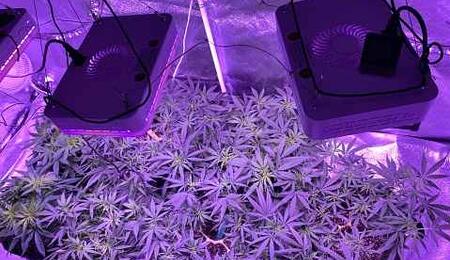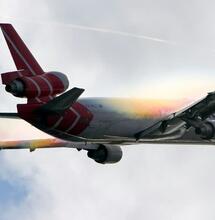The truth about LED lighting.

Once LED lighting was a novelty in cultivation, but this is a long time ago now. Many growers today have experience with using diodes and we don’t have to rely only on what the manufacturers tell us in their advertising. If you are now expecting a propaganda article, or waiting for absolution on which manufacturer is guaranteed to make the best lighting, I’m afraid I must disappoint you. The time is now ripe for us to look objectively at LED lighting.
Plants under 300W LED modules with active cooling
I hope that those of you with accurate knowledge of LED technology will forgive me, but I think it is necessary to describe it first. LED is an abbreviation for Light Emitting Diode. The technology works on the principle of semiconductor wafers which convert electricity directly into light, without the significant by-product of heat, meaning that an LED will convert most of the energy it consumes into light.
For the ordinary user this means that less electricity will be used to achieve the same amount of light as from a bulb. For indoor cultivators, in addition, this means that the nursery will not be significantly heated by the light source in any way, and moreover they will be able to move the source much closer to the plants. It is necessary to add that even an LED does not convert 100% of electrical energy into light, as some people think. Compared with MH and HPS lamps, the efficiency of converting electricity into light is roughly doubled.
So it should be easy to deduce that a 600W HPS lamp can be replaced by a 300W LED module, which of course isn’t entirely true, as we will see in a few paragraphs. If you are interested in when and where LED technology began, you should know that it is necessary to look back to the beginning of the 20th century, when the British experimenter H.J. Round discovered electroluminescence in the Marconi laboratories in 1907. In 1927, the Russian Oleg Losev announced the production of the first electroluminescent diode, which was the original name of LEDs.
Diodes can shine in different bands on the light spectrum, from ultraviolet to infrared (which you will know, for example, from the remote control for your television). The colours of light, in simplified lay terms, depend on the chemical composition of the semiconductor. People say, and on the internet you will find, that the development of blue and white LEDs, which are used in modules for cultivation of plants, took a relatively long time.
What is certain is that the option of choosing the band of the spectrum is an enormous advantage of LEDs. Of course, major research is pursuing a completely different direction than that of cultivation. The goal of researchers was to develop a light source which could replace natural daylight and would produce light at a lower cost than existing bulbs and alternative fluorescent illumination (low-energy light bulbs and fluorescent lamps, which is not an entirely accurate designation, but we all use it). Since saving energy has been cited as the main advantage of LEDs, it is necessary to state that, in order for the diodes to light up, we need a control and power module.
Printed circuit boards are commonly used. A disadvantage of LED technology is its low tolerance of high temperatures, so it is necessary to cool the module in some way. The efficiency of the cooling system has a significant impact on the service life of the diode, which under optimal conditions is incomparably longer than that of traditional bulbs. The service life of an LED is also one of the selling points put forward by producers of this technology. If the cooling is inadequate, it may lead to damage to or interruption of circuits, which could result in total or partial failure of the lighting equipment. Some types of diode will start to flicker or will simply stop shining.
The fact that damage does not as a rule affect every section, meaning that the lights will still partially shine, is something of a silver lining. As already stated, overheating the module can be avoided by cooling it, either actively or passively. The majority of modern LED modules for cultivation of plants have continuous active cooling. In practice this means that the module is equipped with one or more ventilator fans, which dissipate the heat away from the source and the printed circuit boards with the diodes. The amount of heat is incomparably lower than that emitted by HPS or MH bulbs – just for the record.
An example of a passive cooling system could be an aluminium fin module connected to the LED module. The cooler dissipates the heat passively. You will find a similar device in your computer. It has probably already occurred to you that active cooling will use a few extra Watts of power – and you’re right, of course. It may also be a problem that active cooling isn’t completely quiet. Personally I think that the sound made by small ventilator fans is not coming from the noisiest device in the growroom, but we can certainly agree that passive cooling, which operates quietly and economically, is more suitable for a growroom. The most recent developments in LED cultivation modules are also moving in that direction and manufacturers are endeavouring to use passive cooling systems.
A 12 volt LED module with passive cooling
Let us now look at where LED modules originate from. Officially, the majority of manufacturers claim that their LED modules are made in Europe. This may be true, but only up to a certain point. Modules may be assembled here, but most of the components, including diodes and connections, are made in China. This in itself does not mean that the modules or diodes are poor quality. After all, China produces at least some of the electronic components of many world-famous brands, including for those who sell themselves on their quality.
The reality is that manufacturers choose the components from which the cultivation module is to be assembled, and that, in essence, is the main thing. So as long as the producer chooses the more expensive and better-quality components, they can provide high-quality cultivation lighting, even if it is labelled ‘Made in China’. If you follow the cultivation equipment market, you will certainly have noticed how many new firms making cultivation LEDs appear every year.
In the previous paragraphs I have mentioned enough basic information which will determine whether or not the LED module is good quality. All of these indicators are not totally irrelevant, unless the module emits light in the correct band of the spectrum. We growers also need LED modules that are energy efficient, are not noisy and most importantly, those modules under which the plants will show strong signs of growth and significant flower formations. Simply put, we need strong stems and large, hard buds, and we will achieve this combination only if we have the correct composition of light.
As already stated, the cultivation of plants is not the main concern of world leaders in lighting developments. Firms like OSRAM and PHILIPS earn far and away more money by developing LED bulbs for your table lamps or chandeliers for your living room. And since diodes are easy to get hold of and any handyman can assemble an LED module in his small workshop, many enthusiasts have thrown themselves into the development of the correct light combination for cultivation. The basic guidance information on what band of the light spectrum is suitable for growth and which for flowering has been known for a long time now.
Nevertheless, in order to obtain really functional light it is necessary to create a precise combination, and on the basis of practical experience, to add here and subtract there. The first LED modules for marijuana cultivators had one enormous disadvantage: the plants under them did not flower well. They flowered, but the size and hardness of the buds could not be compared with the cultivars obtained under HPS bulbs. This initial problem gave LED technology such a bad name among growers that even today you will struggle to convince some experienced cultivators, let alone novices, that developments have moved forward and that it is possible to use LEDs to grow really excellent supplies.
A series of LED modules with passive cooling
Let’s turn to practice now. How often have you heard that, when cultivating under LED modules, you will obtain a yield of two grams per Watt of energy consumed? In other words this would mean, that under a 300W LED module you will cultivate 600 grams of supplies? Yes, I’ve heard this a few times too. But I’ve never seen it – and I would very much like to. I have two criticisms. A 300W LED module with active cooling must have either a lower power output, or higher consumption. The reason is simple. If I populated the module with 300 diodes of 1 Watt each (author’s note: recently it has been possible to observe the advent of 3W diodes), I certainly have a 300W module, but I still need an active cooler, which with this output will still be used frequently.
This means that the power consumption of the module is actually several tens of Watts higher, so the conversion to grams is distorted. My second criticism is that my own proven experience, and that of others, cannot confirm this result even by chance. I can get a maximum stable return of 1.4 grams per Watt when cultivating classic varieties and clones and with a minimum 14 day growth phase. The most frequently asked question in discussions of LED modules for cultivation concerns power. How powerful an LED module do I need to replace a 600W HPS bulb? On the basis of current knowledge I can say that the results will be closest if you choose an LED module with power output of around 30 – 40% lower than the HPS bulb you have used up till now.
So you should replace a 1000W bulb with an LED module of 600 – 700W. A 600W HPS bulb can be effectively replaced with a 350 – 400W LED module. You can substitute an LED module of at least 240W for a 400W bulb and a 150W LED module for a 250W HPS bulb. These ratios have been calculated for suitable illumination of a given amount of space. The question of exchanging traditional HPS bulbs for LEDs can also be put in a different way. Is it possible to increase the amount to be harvested in a given space, if I use an LED module of the same power output as my current HPS bulbs?
Put simply, what will happen if instead of a 600W HPS bulb you hang a 600W LED module in your growroom? There is no entirely clear answer. This would be expected to increase the weight of the crop by 30 – 40%. In such a case we would still be able to say that if we illuminate an area of 1 x 1 metres with a 1000W HPS bulb, we would obtain a 40% larger harvest. This is of course not true, because we always have to use a lamp whose output corresponds to the area we intend to illuminate. LED modules can thus primarily be used to achieve the same results while reducing electricity consumption, and not to increase the yield with the same consumption.
A really small LED module is enough for ordinary plants
What else do we know about cultivating under LED? In the first part of this article I mentioned that LED modules do not emit heat, or rather that they only emit a little, in comparison with HPS bulbs. This gives an enormous advantage to the cultivator who has a problem with excessive temperatures in the nursery. This problem can occur in sun-exposed houses, attic flats, roof growrooms etc. and of course occurs more frequently and for a longer period of the year in countries nearer the equator. For this reason the demand for LED modules is higher in countries with higher daytime temperatures than in those in the temperate zone – the principle reason for buying LEDs there is their economical operation.
I have just stumbled across temperature. If you don’t need to cool the growroom too much, you don’t run the air conditioning and not even a ventilator fan needs to run on a high gear. You will therefore save money not just on electricity for lighting, but also for ventilation. But what should you do if you need the warmth of traditional HPS bulbs for cultivation? You have two options – equip your growroom with heating, which has the possibly undervalued advantage of lower consumption of LED modules (for electric heating) or reach for your HPS bulbs again. By this I mean one thing: LED cultivation technology is not suitable in every case.
If you have a nursery at home in the attic, LEDs are very suitable for you, because there is usually more heat, not less, in spaces like these. If, by contrast, your nursery is in the cellar, or in an unheated house, your problem will rather be low temperatures and therefore it will be worth using HPS bulbs which will give the plants sufficient warmth and light. Not long ago I met a producer of LED cultivation modules. His is the third generation of his family to be employed in artificial lighting for ordinary greenhouse plants.
He told me one very interesting thing that I hadn’t thought about up till then, and which has genuinely caught my attention. There is nothing new in the fact that diodes emit light in a cone shape. In a cultivation LED module there are a number of diodes of different colours. The cultivator needs the light from all diodes to combine so that all plants receive the same dose of light throughout the intended range. Therefore it is important that the source of light is not too close to the plants. The absolutely perfect solution is a moving light source, in this case an LED module which moves above the plants and guarantees the same supply of the spectrum for all the plants.
A blue light-emitting diode
Have I forgotten anything? Yes, here are a few last pieces of information. Under LED illumination the buds will not usually reach the same size as under HPS bulbs, but in total there will be more of them, and even the bottom ones will be worth it. When cultivating under several lamps it is an advantage to replace half the HPs bulbs with LED lights at half the power. The harvest will in this case be the same and the consumption of electricity will be lower. Of course you must still ensure that the temperature does not rise much above 30 °C.
In conclusion I should perhaps state that for small domestic cultivation, or microcultivation, modules powered by 12V are suitable. Their great advantage is simple passive cooling and sufficient power. The single and final disadvantage of the technology remains its somewhat high price. This is of course relative, because you will see returns on your lowered electricity costs, which you will be able to calculate for yourselves. I wish you much success in the practical use of LEDs for your plants.



